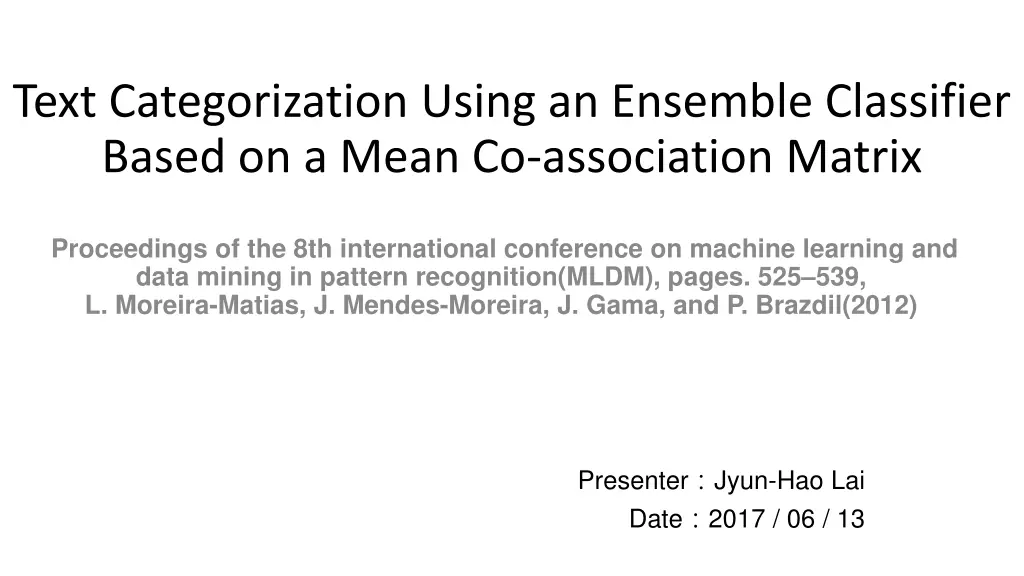
Text Categorization Using Ensemble Classifier and Mean Co-association Matrix
"Explore the methodology MECAC for text categorization, leveraging an ensemble of classifiers with parallel computing capabilities and statistical validation. Learn about the process involving classifier training, agreement matrix calculation, and document clustering for improved performance in machine learning tasks."
Download Presentation

Please find below an Image/Link to download the presentation.
The content on the website is provided AS IS for your information and personal use only. It may not be sold, licensed, or shared on other websites without obtaining consent from the author. If you encounter any issues during the download, it is possible that the publisher has removed the file from their server.
You are allowed to download the files provided on this website for personal or commercial use, subject to the condition that they are used lawfully. All files are the property of their respective owners.
The content on the website is provided AS IS for your information and personal use only. It may not be sold, licensed, or shared on other websites without obtaining consent from the author.
E N D
Presentation Transcript
Text Categorization Using an Ensemble Classifier Based on a Mean Co-association Matrix Proceedings of the 8th international conference on machine learning and data mining in pattern recognition(MLDM), pages. 525 539, L. Moreira-Matias, J. Mendes-Moreira, J. Gama, and P. Brazdil(2012) Presenter Jyun-Hao Lai Date 2017 / 06 / 13
Abstract Abstract Text Categorization (TC) has attracted the attention of the research community in the last decade. Algorithms like Support Vector Machines, Na ve Bayes or k Nearest Neighbors have been used with good performance, confirmed by several comparative studies. Recently, several ensemble classifiers were also introduced in TC. However, many of those can only provide a category for a given new sample. Instead, in this paper, we propose a methodology MECAC to build an ensemble of classifiers that has two advantages to other ensemble methods: 1) it can be run using parallel computing, saving processing time and 2) it can extract important statistics from the obtained clusters. It uses the mean co-association matrix to solve binary TC problems. Our experiments revealed that our framework performed, on average, 2.04% better than the best individual classifier on the tested datasets. These results were statistically validated for a significance level of 0.05 using the Friedman Test.
Step 1 The Classifiers Training A set of classifiers is generated by applying k classification algorithms to our training set X. ? = {?1,?2, ,??} contains the class determined by the classifiers to our test set. k = 3, data = 5 class-label = [[0, 1, 1, 0, 1], [1, 0, 1, 0, 1], [1, 1, 0, 1, 0]]
Step 2 The calculus of the Agreement Matrix ? ?,? = 2? 1?? ? > 0 ,?,? 1, ,? . 0 ?? ? = 0 ? = [[1 2 1 2 1] [2 1 2 1 2] [4 2 1 2 4] [0 1 2 1 0] [4 2 1 2 4]] ????? ????? = [[0, 1, 1, 0, 1], [1, 0, 1, 0, 1], [1, 1, 0, 1, 1]]
Step 3 The Document Clustering Use ? as input of ?-means algorithm to form 2 clusters of documents ?1, ?2and use SVM classifier to class them. clusters = 2 ? = [[1 2 1 2 1] [2 1 2 1 2] [4 2 1 2 4] [0 1 2 1 0] [4 2 1 2 4]] [0, 0, 1, 0, 1]
Algorithm Step 1 The Classifiers Training Step 2 The calculus of the Agreement Matrix Step 3 The Document Clustering
from sklearn.cluster import KMeans m = np.zeros((5,5), dtype=int) class_label = [[0, 1, 1, 0, 1], [1, 0, 1, 0, 1], [1, 1, 0, 1, 1]] for o in range(0, 5): for j in range(0, 5): for b in range(0, 3): for i in range(b + 1, 3): if class_label[b][o] == class_label[i][j]: print('b = ', b, ' o = ', o, ' and i = ', i, ' j = ', j) print(' before m[', o, '][', j, '] = ', m[o][j]) if m[o][j] == 0: m[o][j] = 1 else: m[o][j] = m[o][j] * 2 print(' after m[', o, '][', j, '] = ', m[o][j]) num_clusters = 2 km = KMeans(n_clusters=num_clusters) km.fit(m) print(km.labels_.tolist()) #[0, 0, 1, 0, 1]
Result Dataset 21578 1987 2 26 1987 10 9 21,578 135 7 5 dataset Class 1 Class 2 DS1 Wheat Money-FX DS2 Sugar Interest DS3 Sugar Crude DS4 Interest Coffee DS5 Grain Crude
Result SVM Support Vector Machines KNN k Nearest Neighbors NB Na ve Bayes Nnet Neural Networks EnsB 4 Ens1 4 Ens2 Bayes
Result SVM ENS2 ENSB ENS2
